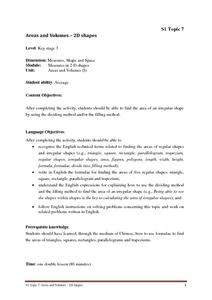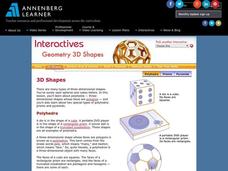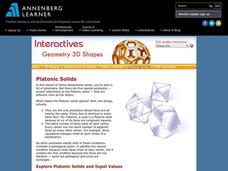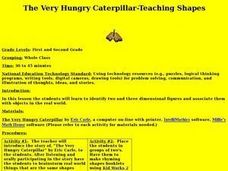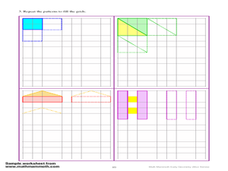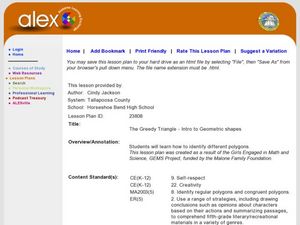Government of Hong Kong
Areas and Volumes - 2D Shapes
Unfortunately for young mathematicians, the world isn't made entirely of parallelograms, triangles, and trapezoids. After first learning the area formulas for these common shapes, students apply this new knowledge to...
Curated OER
Recognizing 3D Shapes, Part 3
Do your first graders know the difference between cones and cylinders? Use this handy activity to help youngsters learn geometric shapes. With prisms, spheres, and pyramids, among others, this resource prompts pupils to identify each...
Annenberg Foundation
Geometry 3D Shapes: 3D Shapes
Explore vocabulary related to three-dimensional shapes. An instructional website describes the characteristics of different geometric solids. Learners can use an interactive component to view nets, faces, vertices, and edges of common...
PhET
Molecule Shapes
The shape of a molecule is determined by the arrangement of atoms around the central atom and lone pairs of electrons. Scholars build models of molecules using single, double, and triple bonds. They can then see real molecules bond...
Learner
Solid Shapes
A collection of two lessons, kindergartners will identify two-dimensional shapes in solid shapes. They will develop basic knowledge of the components that make up a sphere, rectangular prism, pyramid, cylinder, cone, and cube. Young...
Mathematics Vision Project
Module 5: Modeling with Geometry
Solids come in many shapes and sizes. Using geometry, scholars create two-dimensional cross-sections of various three-dimensional objects. They develop the lesson further by finding the volume of solids. The module then shifts...
Annenberg Foundation
Geometry 3D Shapes: Platonic Solids
From polyhedrons to platonic solids, here is a lesson that will have your classes talking! As an introduction to platonic solids, scholars cut and fold nets to create the three-dimensional solids. They use an interactive component to...
Annenberg Foundation
Geometry 3D Shapes: Euler's Theorem
How do you get a theorem named after you? Euler knows what it takes! The third lesson of five asks pupils to use an interactive activity to compare the faces, vertices, and edges of seven different three-dimensional solids. They use...
Curated OER
Geometric Shapes, Construction Perspective
Learners examine three different geometric solid shapes and their nets. They answer multiple choice, spatial awareness questions where they determine which view: front, top or either, the net represents.
Curated OER
Circles 1, 2, 3, 4
Here is a way to help your charges identify circles and spheres. In this shapes geometry and technology lesson, students identify and draw circles and explain the related attributes. They recognize circles and spheres while exploring...
Curated OER
Geometry, Shapes and Public Sculpture
Students explore characteristics of geometric shapes. They observe geometric shapes and forms in public sculpture. Students create a unique sculpture of their own using basic three dimensional shapes. Additional cross curriculum...
Curated OER
The Very Hungry Caterpillar - Teaching Shapes
Young scholars identify two- and three-dimensional figures and associate them with real-world objects. In this geometry instructional activity, students are read The Very Hungry Caterpillar by Eric Carle and complete several...
Curated OER
Shapes
Fifth graders explore shapes. They recognize and name two-dimensional and three-dimensional shapes. Pupils discuss the properties and criteria for each shape they find in real life and construct a Kid Pix project using pictures of the...
Curated OER
Drawing Basic Shapes
Challenge your geometry class with this connect-the-dots activity! Scholars use a ruler to complete simple shapes through connecting dots in 6 shape-identification problems, and identify it from 4 choices: triangle, square, rectangle, or...
Kuta Software
Identifying Solid Figures
Reinforce basic geometry skills in an elementary math lesson. A simple activity prompts learners to identify and label 3-D shapes.
Curated OER
The Greedy Triangle-Intro to Geometric Shapes
In this geometry lesson plan, learners read The Greedy Triangle and use geoboards to construct geometric shapes. They identify the number of sides and angles each shape has.
Curated OER
Finding the Area of Shapes
In this area of shapes unit, upper graders participate in hands-on problem solving activities to find the formulas for the area of a parallelogram, a triangle, and a trapezoid. They manipulate the geoboard to explore relationships among...
Curated OER
Third Grade Geometry
Third graders describe 2D and 3D shapes. For this geometry lesson, 3rd graders watch a PowerPoint presentation showing the terms used when analyzing shapes: vertex, edge, angle, side, and face. They compare shapes to see what they have...
Curated OER
Analyzing 3-D Shapes and 2-D Representations
Students can analyze 3-D objects better with actual physical models and by also drawing 2-D representations of them.
Houghton Mifflin Harcourt
Unit 3 Math Vocabulary Cards (Grade 1)
Reinforce math vocabulary with a set of flashcards. Each card showcases a boldly typed word or a picture representation with labels. The topics are geometry related and include terms such as cones, faces, pyramids, sides, and...
Curated OER
Geometry and Rubik's Cube
Students explore geometry using a Rubik's Cube. In this 2-D and 3-D shapes instructional activity, students use the Rubik's Cube to find the center, edge and corner pieces. Students then find the dimensions of the Rubik's Cube and read...
Curated OER
Cylinder: Student Worksheet
Pairs of geometry whizzes work together to determine which of three differently shaped cylinders will have the greatest volume. Pupils cut out the three rectangles embedded in the plan, and tape them together to form a cylinder. From...
Curated OER
Math - "Solid Shapes" - Comparing 3-D Objects
In this geometry worksheet, students learn about 3-D objects and how to describe them. They then answer 10 questions using the information they learned. The answers are on the last page.
Utah Education Network (UEN)
Geometry
Shape one's understanding of geometry using the resource. The sixth of seven chapters in 6th Grade Math focuses on geometry principles. Future mathematicians learn to find the area of parallelograms, trapezoids, triangles, and other...


